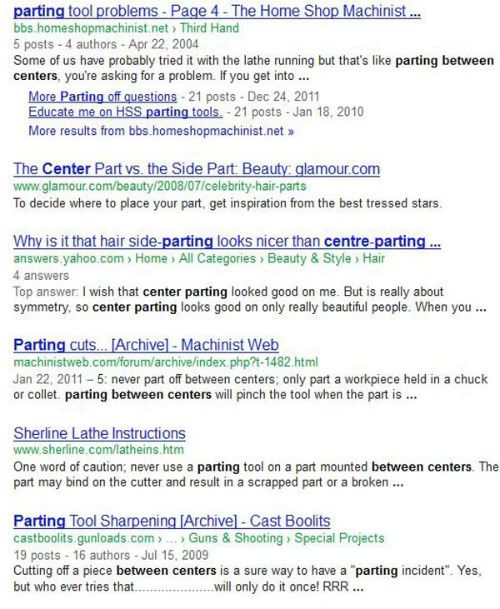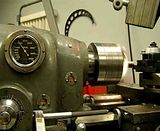arnoldb
Well-Known Member
- Joined
- Apr 8, 2009
- Messages
- 1,792
- Reaction score
- 12
I'm not a professional, nor even accomplished amateur machinist, but I strongly support the point of view of everyone who has stated not to part all the way through with tailstock support.
On one of my earliest parting attempts a couple of years ago I did try to do this; I ended up with a broken parting blade, a ding on my lathe bed that I had to flatten off, and a ruined workpiece. Not to mention the fact that I had to walk very carefully to the bathroom to get rid of the pair of pants I was wearing... Lesson learned.
I am concerned about the way some of the parting advice has been provided through this thread, without addressing the specifics of the parting jobs needing to be done. And different lathes will also behave differently while parting off.
A lot depends on the job in hand, and the size of the workpieces coming off. I often have a need for additional support while parting off - sometimes it's because I have to make a parting cut quite a distance from the chuck, other times it's because there's a fair length of workpiece that would come off while parting and sometimes purely to compensate for wear in my lathe's headstock bearings.
This is where I feel a bit of "thinking" is actually the first machining operation. Think through the entire operation before actually physically doing it, and then set up the lathe to mitigate any safety issues.
Sometimes it's just plain necessary to do a parting cut part way through with tailstock support, and then finish the cut with a hacksaw.
If you have a long piece that will come off, it might be the right time to mount up that fixed steady that's been collecting dust in the cupboard to help stabilize workpieces and prevent things bending and whipping around.
As has been stated, a workpiece with a hole in the center can be captured on a pin or bit of rod in the tailstock. I've used this method with some grease/thick oil smeared on a bit of rod that's a running fit in the workpiece hole to actually provide some rigidity to a parting cut. With this method it's easy to completely part off a workpiece, as it will just end up sitting on the pin.
For solid pieces, a piece of pipe chucked in the tailstock can be used to catch the workpiece and prevent it from flying off or landing in the swarf during a full parting cut.
For small jobs like making nuts where I don't want to damage the threads by using a pin, I regularly use a rattle-can cap to capture the nut when parting it off. Saves a dig through the swarf mountain.
I find some of the earlier posts in this thread bordering on insulting and some demeaning of beginners... Lets keep posts civil Gents. We have members of varying abilities with vastly different selections of tooling available here on HMEM - please keep this in mind when posting advice or comments.
Regards, Arnold
On one of my earliest parting attempts a couple of years ago I did try to do this; I ended up with a broken parting blade, a ding on my lathe bed that I had to flatten off, and a ruined workpiece. Not to mention the fact that I had to walk very carefully to the bathroom to get rid of the pair of pants I was wearing... Lesson learned.
I am concerned about the way some of the parting advice has been provided through this thread, without addressing the specifics of the parting jobs needing to be done. And different lathes will also behave differently while parting off.
A lot depends on the job in hand, and the size of the workpieces coming off. I often have a need for additional support while parting off - sometimes it's because I have to make a parting cut quite a distance from the chuck, other times it's because there's a fair length of workpiece that would come off while parting and sometimes purely to compensate for wear in my lathe's headstock bearings.
This is where I feel a bit of "thinking" is actually the first machining operation. Think through the entire operation before actually physically doing it, and then set up the lathe to mitigate any safety issues.
Sometimes it's just plain necessary to do a parting cut part way through with tailstock support, and then finish the cut with a hacksaw.
If you have a long piece that will come off, it might be the right time to mount up that fixed steady that's been collecting dust in the cupboard to help stabilize workpieces and prevent things bending and whipping around.
As has been stated, a workpiece with a hole in the center can be captured on a pin or bit of rod in the tailstock. I've used this method with some grease/thick oil smeared on a bit of rod that's a running fit in the workpiece hole to actually provide some rigidity to a parting cut. With this method it's easy to completely part off a workpiece, as it will just end up sitting on the pin.
For solid pieces, a piece of pipe chucked in the tailstock can be used to catch the workpiece and prevent it from flying off or landing in the swarf during a full parting cut.
For small jobs like making nuts where I don't want to damage the threads by using a pin, I regularly use a rattle-can cap to capture the nut when parting it off. Saves a dig through the swarf mountain.
I find some of the earlier posts in this thread bordering on insulting and some demeaning of beginners... Lets keep posts civil Gents. We have members of varying abilities with vastly different selections of tooling available here on HMEM - please keep this in mind when posting advice or comments.
Regards, Arnold







